No spring Irisses here yet....I'll remedy that ;) In flower here now and during the last couple of weeks:
Iris 'Gordon'
Iris hyrcana
Iris 'Katherine Hodgkin'
Iris 'George'
Iris 'Rhapsody'
Iris 'Blue Ice'
Iris histrioides 'Angel's Tears'
Iris 'Pixie'
Iris 'Ruby'
and Iris 'Alida'
Comments
Re: Iris 2012
I'm not sure, Trond. It appears to be in the "siberian group" - maybe Iris setosa?
cheers
fermi
Re: Iris 2012
I think Fermi is right, Trond!
Iris setosa subsp. canadensis
Re: Iris 2012
I've been kind of waiting for Todd Boland to weigh in here. He is the best expert we have here, I think, on this beardless iris.
I tentatively agree.
Iris setosa subsp. canadensis is a synonym for Iris hookeri.
Re: Iris 2012
Thanks all of you! I had quite forgotten the plant till I noticed the blue flowers among the weeds! (I did a little weeding afterwards)
Re: Iris 2012
Yes, I'll confirm Trond's iris as Iris hookeri (aka I. setosa ssp. canadensis)...that Iris is endemic to the Gulf of St. Lawrence, eastern North America, with the largest population located in Newfoundland. Didn't I send you seed of this Trond? I thought I sent seeds of a lavender, very dwarf form.
Re: Iris 2012
Yes, I'll confirm Trond's iris as Iris hookeri (aka I. setosa ssp. canadensis)...that Iris is endemic to the Gulf of St. Lawrence, eastern North America, with the largest population located in Newfoundland. Didn't I send you seed of this Trond? I thought I sent seeds of a lavender, very dwarf form.
Thanks Todd! Yes in fact you sent me two different forms and I have two huge potfulls of seedlings from last year which already start sprouting outside. They didn't flower as yearlings though! Maybe this year?
The pictured plant is probably something I've bought or got from somewhere - suddenly I noticed the flowers last spring at my summerhouse :-)
Re: Iris 2012
All nice ones- great range of colours, Wim! - I think I like all Irises- except some of the monstrous ruffly hybrids! :o
Really love to see good patches of retics :) Need to get some more- I only planted one little batch several years ago, and last year they did not do much, may need a different site... (Muscari is increasing beautifully in that bed!)
I have I setosa canadensis small seedlings from seed from Kristl (Nova Scotia population) from a couple of years ago, have to plant them out this year!
Re: Iris 2012
So many really nice iris, Wim!
Iris setosa ssp. canadensis (now Iris hookeri) was the first species iris I ever grew. It came form a Chapter plant sale,. As an introduction to species iris, I think it is the very best one for a newbie grower. It is easy, adaptable to different climates, floriferous, colorful, yet intricate and not overpowering.
Iris hookeri nana
Re: Iris 2012
David, good to see such a deep color form, but I'm not sure your plant is well, both the foliage and flower give the impression of a possible virus.
Re: Iris 2012
You're spot on Mark and it's also been confirmed on the SRGC Forum. This one is virused too-Iris lutescens alba-and both plants are now in the bin :(
Re: Iris 2012
Pity David
couldn't you keep the plant a little longer to save seeds ??
I am searching Iris lutescens alba sins a few years
Roland
Re: Iris 2012
For a minute there, Tom, I thought that was very late for New Mexico; then I saw you were zone 5/6 - no wonder. Katherine Hodgkin is one of my favorites.
Iris suaveolens - an old patch and a 3 year "seedling". No new growth, just evergreen foliage.
Re: Iris 2012
Nice, Tom.
Iris suaveolens is usually the first to open in my garden.
Re: Iris 2012
Looking good, Tom.
Iris suaveolens is the first to bloom here too, Rick.
Re: Iris 2012
AAAAAHHHHHHHHH
my first flower buts from Iris luteolum where eaten by slugs
I spoiled them today with some mesurol
and hope to see later some flowers (and seeds)
Roland
Re: Iris 2012
Just a minor aside. The NARGS gallery has the same plant showing for Iris suaveolens and Iris attica.
(but the angle of the photo is a little differrent) ;-)
It's blooming here in Massachusetts USA, but initally it was difficult to distinguish the greenish yellow flowers from the leaves. (must have bought it from a catalog without photos, but it is a sturdy grower in the sand bed)
Charles
Re: Iris 2012
Just a minor aside. The NARGS gallery has the same plant showing for Iris suaveolens and Iris attica.
(but the angle of the photo is a little differrent) ;-)
Yes, it certainly does look like it, Charles, as the backgrounds appear to the same in the two photos.
Todd, could you please look into this?
Re: Iris 2012
I wonder why nobody is posting any onco-iris.
Here are a few to start with:
Iris paradoxa - a collection from Armenia
Iris acutiloba ssp. acutiloba
Iris paradoxa - a collection from Lake Sevan, Armenia
Re: Iris 2012
I wonder why nobody is posting any onco-iris.
Thanks for remedying that, Luc, by posting. They are indeed gems. Even in my cold climate, my mind wants to grow regelias or perhaps onco-regelia crosses, but I haven't built up the courage yet. They are all stunning, in my opinion.
Re: Iris 2012
Walking the garden today, I seemed to have caught Iris attica in a most beautiful stage of senescence.
In the first photo: left flower just opened, right flower one day old.
In the second photo: Three days old. 8)
Re: Iris 2012
Luc, don't hesitate tow show more of your wonderful Onco's over here too, they are sublime!
Two SDB Irisses in flower here now:
Iris 'Rabbit's Foot'
and Iris 'Well Suited'
Re: Iris 2012
Two more SDB's in flower:
A white one with no name
Another with no name
and Iris 'Sky Blue'
Re: Iris 2012
Who grows Iris lutescens White form
and can spare a few seeds
Roland
Re: Iris 2012
Wim,will you let me know if you get a name for that yellow Iris,No 2 picture, as I also have it with a no name label.
Cheers.
Re: Iris 2012
May is little Iris time here. I got 'Candy fluff' and 'Sleepy Time' at Poker Hill in Vermont. Well before that I was growing the "dwarf purple" one which may have come from Addison Gardens. Zdenek Zvolanek liked the "dwarf yellow" one so much, that when he saw it in a friend's Canadian garden, he begged a piece. I don't know if he still refers to it as Michael's Iris. Zdenek? I can add just a little more to its story: I got it at a local Master Gardener's plant swap in the earliest days of my rock gardening, if not before. Good, even great plants can turn up anywhere! I never studied it, but there is, or was some fellow by the name Hermit Meddler who offered a stunning array of these little Iris.
Re: Iris 2012
Every one of them is nice- Sleepytime has an especially nice colour- and nice to see the spreading patches too..
Re: Iris 2012
What a beauty, Luc!
Re: Iris 2012
Iris prismatica I think? Flowering for the first time and grown from SRGC Seed Ex. seed sown September 2009.
Re: Iris 2012
Luc- i remember some of your great oncos- they really can't be beat for colours!
David- that seems quite quick flowering, nice work!
Re: Iris 2012
Lis, I posted the same image on the SRGC Forum and the general view was that it wasn't Iirs prismatica (it didn't check out with the description Brian Mathew gives in "The Iris") more likely to be a Pacific Coast hybrid. Never mind, it's quite pretty and I shall keep it.
Re: Iris 2012
Iris graminea flowers hide in the foliage. But the foliage is so graceful, deep green, durable, insect free and non-floppy that I have wondered why these characteristics have not been prized by breeders.
A seedling from Iris setosa 'Tourist'.
Iris sintenisii var. brandzae amidst Corydalis cheilanthifolia.
Re: Iris 2012
Fun to see the significant variations on what is still a clear Iris theme! I like them all :)
Luc- wow!
Re: Iris 2012
Truly breathtaking, Luc. Especially the last iris acutiloba.
:o :o :o
Re: Iris 2012
Typically with rather floppy standards, this is Iris sanguinea.
And a nice powder blue form that appeared in my seed grown collection:
Re: Iris 2012
Nice ones Rick
Small typo
must be Iris sanguinea
Roland
Re: Iris 2012
I do love the Iris season, here are some of mine:-
Two I. sibirica cultivars, the first 'Perry's Blue' (although there could be a label walkabout involved here!) the second 'Sparkling Rose'
Iris pseudacorus-this grown from Exchange seed (labelled Iris tectorum!) that thrives, surprisingly in one of the driest parts of my garden. Incidentally I have another pseudocorus elsewhere in the garden also grown from mislabelled seed.
Also seed grown-Iris graminea
Re: Iris 2012
I could have sworn that "i" was in there, Roland.
Fixed. Thanks. :)
Re: Iris 2012
A few more Iris sibirica pictures:-
Iris sibirica 'Chartreuse Beauty'
Iris sibirica 'Outset'
Iris sibirica seedling-grown from seed scrounged (with permission) from a National Trust garden.
Re: Iris 2012
Iris 'george'
I understand it is a hybrid of Iris histrioides and Iris reticulata.
Still only one healthy bulb after many many years :'( --just wish it showed some hybrid vigour --at least for me.
I'll take another shot when it's fully out.
Cheers Dave
Re: Iris 2012
Maybe it need a little more fertiliser
Here they multiply well
Roland
Re: Iris 2012
Thanks for that Roland
Never thought of that !.
I don't think i've ever fed it ...Duh !!
I'll 'nuke' ;) it with bone meal and see what happens .
Cheers Dave.
Re: Iris 2012
Maybe also with an ordinary fertiliser like 12-10-18 + micro or spore elements
Bonemeal is fantastic
but a very slow fertiliser
also maybe a little chalk , Dolomite or whatever you call it where you live
if your garden is a little acid
Roland
Re: Iris 2012
Dave,
"George" does well for us but I'm pretty sure we're a lot drier than you are!
We don't feed them and they still multiply but that could be because the soil is a rather rich but heavy "adobe" clay [to which we've added a lot of grit/gravel/sand]. The other thing we do is plant them in raised beds or mounds so that drainage is as good as possible.
cheers
fermi
Re: Iris 2012
Fermi
What type of soil do you have
I have to try this one in my garden
they don't like much my potting mixture
but probably my soil is to wet in the summer
Roland
Re: Iris 2012
Hi Roland,
We are on heavy adobe type black clay! But this iris is planted in a raised bed which has had the soil "amended" by the addition of compost and a lot of coarse sand/grit. In parts of this bed it is almost 50% sand.
We usually have dry summers but the last 2 years they have been quite wet with over 2 inches of summer rain! I think the extreme drainage is the only thing which saved this iris! One small [partly-rotted] bulb was rescued from its pot [which hadn't been kept dry] and was re-planted in almost pure sand - I don't think it put up any growth last year but I just noticed some foliage emerging just this week, so I'm very happy that I didn't lose it altogether.
At present we have more retic iris in flower:
- the first we just bought on the weekend in bud - 'Purple Gem'
'Harmony' is the most popular or at least the most commonly grown retic iris here
This is the main clump of Iris 'George' - originally from a single bulb planted in 2002!
cheers
fermi
Re: Iris 2012
Fermi --i'm not sure if my 'unnamed 'Iris below is I.ret.purple gem ---whatever it is it's such a good 'doer' here --quick to multiply and plenty of blooms.
Pic taken last Sat ,there were 5 flowers open as at today.
Cheers Dave.
Re: Iris 2012
So pleased to see this in bloom today --Iris winogradowii --I used to have a good sized patch in the garden but for some reason they were going backwards --potted up a few ,the last :-\ ,(I'm getting old ), :) or maybe the year before so i haven't lost it altogether.
There is another bulb with a bud yet to open.
I was out with the paint brush just before to try and 'self it' but i wasn't sure if i had managed to transfer any pollen from the anthers to the stigmatic lip ,(i wiped both sides of the anthers ).Does anyone know if i should be able to see Iris pollen with the naked eye ? .Thanks.
Cheers Dave.
Re: Iris 2012
That is such a beauty, Dave! One that is really piquing my interest in the last couple years.
I too have noticed the seemingly sparse pollen on several of the small iris species. I have begun to wonder the same thing: if the pollen grains I do see are really clumps of grains, rather than single grains, and the single grains are just extremely tiny. ??? When I have tried to do what limited hand pollinating I've done with them, success is no better than natural pollination! :-\
On the other hand, maybe I am just clumsy. :D
Re: Iris 2012
Thanks a lot Rick --so you do see some pollen with the naked eye ?....i saw nothing on my brush but i'll keep on trying anyway.
Cheers Dave.
Re: Iris 2012
Thanks a lot Rick --so you do see some pollen with the naked eye ?
Cheers Dave.
It has been my limited experience that these crested species that I have, (I. cristata, lacustrus, minutoaurea) seem to have very little pollen that I can find, but it's not completely absent. I can't say that I've really investigated scientifically, but when I have looked, half of the stamens I pluck have no usable pollen that I can see. The ones that do, just 1-3 grains (or clumps of grains?). I've never checked I. tectororum or I. gracilipes, and my I. koreana and odaesanenesis from seed haven't flowered yet.
I don't have any of the bulbous types more than a year old from seed.
Of the bearded types, I. suaveolens varieties have enough pollen (but not abundant), and I have never investigated my I. lutescens varieties or I. attica.
Re: Iris 2012
Was very surprised today to notice that a potful of Iris odaesanensis seed sown just about 3 weeks ago showed germination; hard to count accurately from the photo, but with 18 seedlings so far. This is the first time seed of spring woodland Iris has germinated so quickly; typically they wait until the following spring to germinate.
Re: Iris 2012
Maybe sowing in high temperatures (relative to spring) is the trick?
Did you soak them at all prior to sowing?
Re: Iris 2012
Maybe sowing in high temperatures (relative to spring) is the trick?
Did you soak them at all prior to sowing?
No, I did not soak the seed. I'm guessing that prolonged high temperatures, combined with deluge tropical downpours from violent thunderstoms the last couple of weeks, might be responsible for early germination; but just guessing.
By the way, I have found that planting Iris odaesanensis on flat ground produces much better plant growth (perhaps getting more moisture) than planting on slopes. Those that I had planted on a slope had rhizomes that all retreated uphill to reach flat ground, those on the slopes eventually dying out.
Re: Iris 2012
It has been my limited experience that these crested species that I have, (I. cristata, lacustrus, minutoaurea) seem to have very little pollen that I can find, but it's not completely absent. I can't say that I've really investigated scientifically, but when I have looked, half of the stamens I pluck have no usable pollen that I can see. The ones that do, just 1-3 grains (or clumps of grains?). I've never checked I. tectororum or I. gracilipes, and my I. koreana and odaesanenesis from seed haven't flowered yet.
I don't have any of the bulbous types more than a year old from seed.
Of the bearded types, I. suaveolens varieties have enough pollen (but not abundant), and I have never investigated my I. lutescens varieties or I. attica.
Thanks again Rick.
Mark
I had to go and have a look at your photo on the PBS of Iris odaesanensis --what a beauty :-*
Cheers Dave.
Re: Iris 2012
Fermi --i'm not sure if my 'unnamed 'Iris below is I.ret.purple gem ---whatever it is it's such a good 'doer' here --quick to multiply and plenty of blooms.
Cheers Dave.
Hi Dave,
I think there is some confusion between 'Purple Gem' and 'Pauline'!
Here's another pic of 'Harmony' taken a week after the one I posted on August 01
- hard to say if it's spread through the Teucrium subspinosum or vice versa!
cheers
fermi
Re: Iris 2012
Wow, echoes (or previews?) of spring! Beautiful, Fermi!
Re: Iris 2012
I definitely have to try more of these spring flowering irises!
Re: Iris 2012
You certainly grow 'em well Fermi. Your hot, dry Summers seem to be the key.
Re: Iris 2012
A couple of Chinese sps out at the moment.
Iris bulleyana is a good 'doer' to about 60cm in height and increases strongly each season.
At the other end of the scale is Iris barbatula --individual blooms are short lived however given some moisture it has repeated.
Cheers Dave.
Re: Iris 2012
Here Iris planifolia Pale blue form starts flowering
found by my wife while I was searching for a white form (and didn't find that day)
Roland

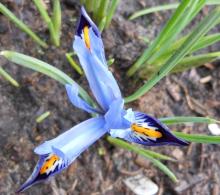
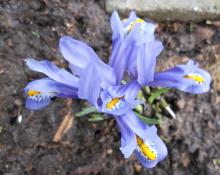
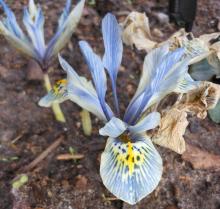
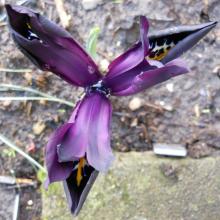
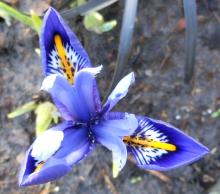
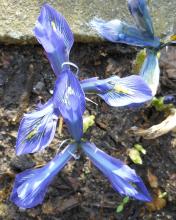

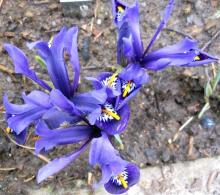
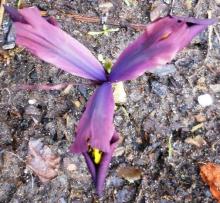
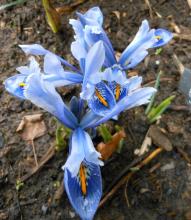
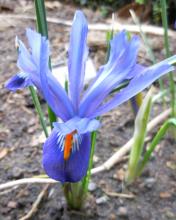
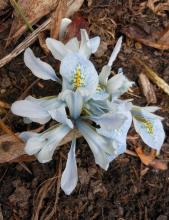
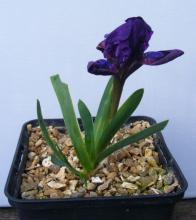
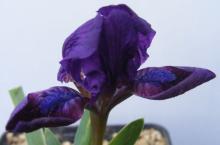
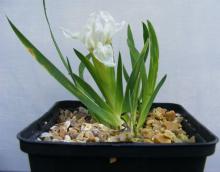
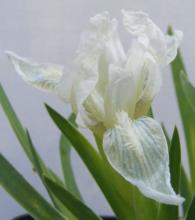
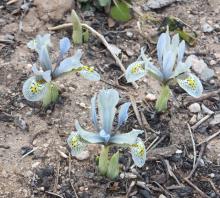
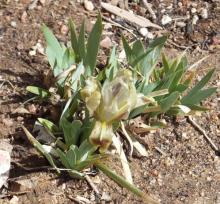
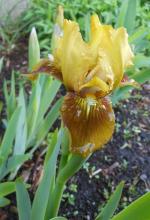
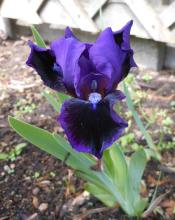
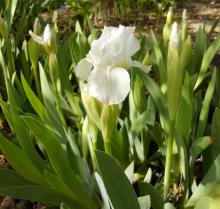
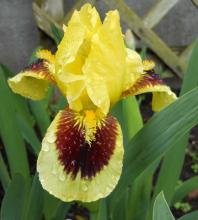
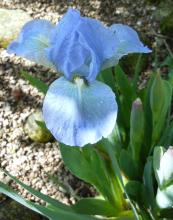
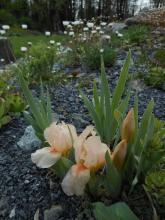
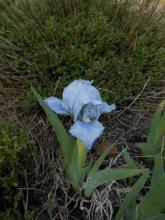
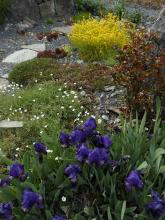
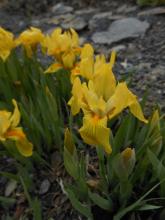
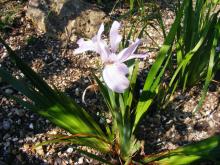
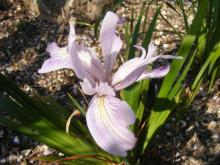
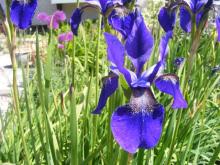
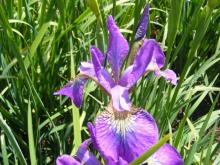

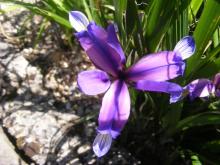
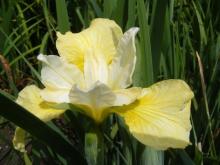
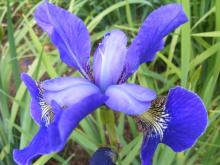
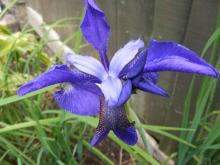
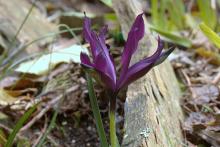
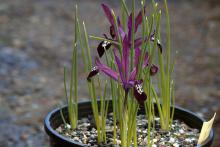
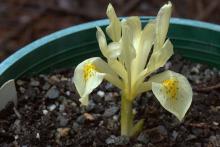
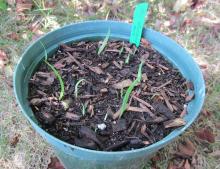
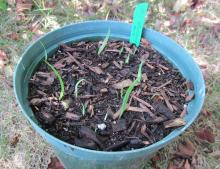
Very tempting Wim! I have only Katherine H but it is still down in the soil. Too cold now. I am planning to plant more spring Irises next autumn.
BTW, does anybody know the name of this one from last late spring?